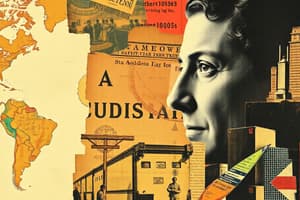Podcast
Questions and Answers
What is the main principle behind the movement of workers in a country according to international specialization of labor?
What is the main principle behind the movement of workers in a country according to international specialization of labor?
Workers move from the less productive sector to the more productive one.
Why is complete specialization on one good considered unrealistic in economic models?
Why is complete specialization on one good considered unrealistic in economic models?
Complete specialization is unrealistic because countries often produce multiple goods rather than focusing solely on one.
What assumptions can make the Ricardian model applicable across multiple countries and goods?
What assumptions can make the Ricardian model applicable across multiple countries and goods?
The model can be applied under simple assumptions such as constant marginal costs and comparative advantage.
In what scenarios does the Ricardian model's assumptions become contested?
In what scenarios does the Ricardian model's assumptions become contested?
What role does comparative advantage play according to the Ricardian model?
What role does comparative advantage play according to the Ricardian model?
What is the main distinction made between bilateral and multilateral economic relations?
What is the main distinction made between bilateral and multilateral economic relations?
How does multilateral trade liberalization affect bilateral inter-dependence?
How does multilateral trade liberalization affect bilateral inter-dependence?
According to the findings, what impact does war have on trade?
According to the findings, what impact does war have on trade?
What prediction was tested regarding globalization and conflict probabilities?
What prediction was tested regarding globalization and conflict probabilities?
What database did the researchers utilize to analyze conflicts between countries?
What database did the researchers utilize to analyze conflicts between countries?
How does income inequality across countries persist in the context of trade?
How does income inequality across countries persist in the context of trade?
What is the main principle behind Paul Krugman's concept of comparative advantage?
What is the main principle behind Paul Krugman's concept of comparative advantage?
What are some misconceptions regarding the disadvantages of an open market?
What are some misconceptions regarding the disadvantages of an open market?
What factors determine country-by-country specialization in trade?
What factors determine country-by-country specialization in trade?
What role does the WTO play in the context of global trade and the liberal order?
What role does the WTO play in the context of global trade and the liberal order?
What is the opportunity cost of cheese in terms of wine for Home?
What is the opportunity cost of cheese in terms of wine for Home?
Which country has an absolute advantage in the production of both cheese and wine?
Which country has an absolute advantage in the production of both cheese and wine?
How does trade affect wages in the industry with a comparative advantage?
How does trade affect wages in the industry with a comparative advantage?
What happens to the relative prices of goods when two countries open up for trade?
What happens to the relative prices of goods when two countries open up for trade?
Why is it beneficial for countries to specialize in the goods in which they have a comparative advantage?
Why is it beneficial for countries to specialize in the goods in which they have a comparative advantage?
In terms of efficiency, how does Home compare to Foreign in producing cheese?
In terms of efficiency, how does Home compare to Foreign in producing cheese?
Calculate the opportunity cost of wine in terms of cheese for Foreign.
Calculate the opportunity cost of wine in terms of cheese for Foreign.
What is the relative productivity of Foreign in producing wine versus cheese?
What is the relative productivity of Foreign in producing wine versus cheese?
What are two main benefits for firms that outsource production abroad?
What are two main benefits for firms that outsource production abroad?
How does economic interdependence differ from the liberal hypothesis?
How does economic interdependence differ from the liberal hypothesis?
Define a global value chain (GVC).
Define a global value chain (GVC).
What role does foreign value added play in production?
What role does foreign value added play in production?
What are the two structural types of global value chains mentioned?
What are the two structural types of global value chains mentioned?
What must a company decide when managing production stages?
What must a company decide when managing production stages?
What is the expected correlation between inward FDI and GVC participation?
What is the expected correlation between inward FDI and GVC participation?
Explain the significance of 'carry-along trade' in relation to GVCs.
Explain the significance of 'carry-along trade' in relation to GVCs.
What is endogeneity in the context of economic sanctions and conflict?
What is endogeneity in the context of economic sanctions and conflict?
Why is the issue of omitted variables important in analyzing trade and war?
Why is the issue of omitted variables important in analyzing trade and war?
What does self-selection imply in the context of countries engaging in trade and conflict?
What does self-selection imply in the context of countries engaging in trade and conflict?
How did early empirical studies view the relationship between trade and political conflicts?
How did early empirical studies view the relationship between trade and political conflicts?
What was Barbieri's (1996) contribution to the understanding of trade and conflict?
What was Barbieri's (1996) contribution to the understanding of trade and conflict?
What is the significance of including observable third factors in multivariate estimations?
What is the significance of including observable third factors in multivariate estimations?
What challenges arise from the infrequent observation of wars and military conflicts?
What challenges arise from the infrequent observation of wars and military conflicts?
According to Martin Meyer Thoenig (2008), what is a key reason for the lack of clear evidence supporting the liberal hypothesis?
According to Martin Meyer Thoenig (2008), what is a key reason for the lack of clear evidence supporting the liberal hypothesis?
Flashcards
Comparative Advantage
Comparative Advantage
The idea that countries specialize in producing goods where they have a relative advantage, leading to higher overall production and trade gains.
Ricardian Model
Ricardian Model
A model that explains trade patterns based on differences in relative productivity between countries. It assumes constant marginal costs and complete specialization.
Consistent Assumptions
Consistent Assumptions
Assumptions that are consistent with comparative advantage include restrictions on trade, trade costs, and variety of goods/services.
Non-consistent Assumptions
Non-consistent Assumptions
Signup and view all the flashcards
Heckscher-Ohlin Model
Heckscher-Ohlin Model
Signup and view all the flashcards
What is Bilateral Trade?
What is Bilateral Trade?
Signup and view all the flashcards
What is Multilateral Trade?
What is Multilateral Trade?
Signup and view all the flashcards
How does the Gravity Model work?
How does the Gravity Model work?
Signup and view all the flashcards
How does trade affect conflict?
How does trade affect conflict?
Signup and view all the flashcards
How does conflict impact bilateral trade?
How does conflict impact bilateral trade?
Signup and view all the flashcards
Unit Labor Requirement
Unit Labor Requirement
Signup and view all the flashcards
Labor Productivity
Labor Productivity
Signup and view all the flashcards
Opportunity Cost
Opportunity Cost
Signup and view all the flashcards
Absolute Advantage
Absolute Advantage
Signup and view all the flashcards
Specialization and Trade
Specialization and Trade
Signup and view all the flashcards
Autarky Prices
Autarky Prices
Signup and view all the flashcards
Price Equalization
Price Equalization
Signup and view all the flashcards
Distributive Effects of Trade
Distributive Effects of Trade
Signup and view all the flashcards
WTO Agreements
WTO Agreements
Signup and view all the flashcards
Trade Benefits Even with Lower Competition
Trade Benefits Even with Lower Competition
Signup and view all the flashcards
Liberal Order
Liberal Order
Signup and view all the flashcards
Omitted Variables (OV)
Omitted Variables (OV)
Signup and view all the flashcards
Self-Selection (SS)
Self-Selection (SS)
Signup and view all the flashcards
Reverse Causality (RV)
Reverse Causality (RV)
Signup and view all the flashcards
Endogeneity
Endogeneity
Signup and view all the flashcards
Simple Correlations and Studies
Simple Correlations and Studies
Signup and view all the flashcards
Multivariate Estimation
Multivariate Estimation
Signup and view all the flashcards
Liberal Hypothesis
Liberal Hypothesis
Signup and view all the flashcards
Trade and Conflict: No Clear Evidence
Trade and Conflict: No Clear Evidence
Signup and view all the flashcards
Benefits of Outsourcing Production Abroad
Benefits of Outsourcing Production Abroad
Signup and view all the flashcards
Fewer Suppliers in Global Production
Fewer Suppliers in Global Production
Signup and view all the flashcards
Economic Interdependence in Global Production
Economic Interdependence in Global Production
Signup and view all the flashcards
Global Value Chain (GVC)
Global Value Chain (GVC)
Signup and view all the flashcards
Key Aspect of Global Value Chains: Foreign Value Added
Key Aspect of Global Value Chains: Foreign Value Added
Signup and view all the flashcards
Configurations of Global Value Chains
Configurations of Global Value Chains
Signup and view all the flashcards
Global Production Networks: Segmentation and Allocation
Global Production Networks: Segmentation and Allocation
Signup and view all the flashcards
Firm-Level Decisions on Making vs. Buying in GVCs
Firm-Level Decisions on Making vs. Buying in GVCs
Signup and view all the flashcards
Study Notes
Economic Security
- Security is the protection of national interests from loss
- Economic security is the interception between elements, e.g., electric vehicles
- The Draghi report addressed economic security issues
Liberal World Order and Trade Integration
- Globalization is the interconnection and interdependence among people, firms, and institutions
- Trade in goods and services is most positively affected by globalization
- Globalization of ideas and activities is also affected by these factors
- Trade fosters specialization and rising incomes
- Restrictions on free trade can reduce well-being
Liberal Approach
- Globalization is the evolution of interconnected networks
- Interdependence creates reciprocal vulnerabilities and cooperation opportunities
- Peace allows for closer integration among countries
- International openness, multilateralism, and rules-based relations are core ideas
- Democratic solidarity and cooperative security are essential for progressive social purposes globally and domestically
Studying That Suits You
Use AI to generate personalized quizzes and flashcards to suit your learning preferences.




